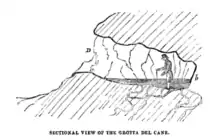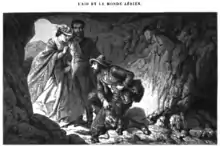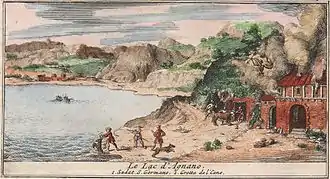Cave of Dogs
The Cave of Dogs (in Italian Grotta del Cane, literally "Cave of the Dog"[1][2]) is a small cave on the eastern side of the Phlegraean Fields near Pozzuoli, Naples.[3] Inside the cave is a fumarole that releases carbon dioxide of volcanic origin. It was a famous, if gruesome, tourist attraction for travellers on the Grand Tour. The carbon dioxide gas, being denser than air, tends to accumulate in the deeper parts of the cave. Local guides, for a fee, would suspend small animals (usually dogs) inside it until they became unconscious. Because humans inhaled air from a higher level they were not affected. The dogs might be revived by submerging them in the cold waters of the nearby Lake Agnano. Tourists who came to see this attraction included Goethe, John Evelyn, Montesquieu,[4] Alexandre Dumas père, and Mark Twain. The lake became polluted and it was drained in 1870; the spectacle fell into disuse (according to one source, it was banned before World War II for cruelty to animals). The cave entrance was blocked to prevent access by children.[5][6][7][8][9]



The cave was often described in nineteenth century science textbooks to illustrate the density and toxicity of carbon dioxide,[10] and its reputation has given rise to a popular scientific demonstration of the same name. Stepped candles are successively extinguished by tipping carbon dioxide into a transparent container.
In 2001 the cave was investigated by Italian speleologists including Rosario Varriale. Nine metres from its entrance the temperature was 52 °C (126 °F) and the CO2 concentration was 80%, with negligible oxygen. It appeared to have been constructed in classical antiquity, possibly as a sudatorium; if so, the atmospheric conditions must have been markedly different.[11]
References
- HALLIDAY, William R; ClGNA, Arrigo A (2006). "The Grotta Del Cane (Dog Cave), Naples, Italy" (PDF). CAVE AND KARST SCIENCE , 2006 Transactions of the British Cave Rescarch Association. 33 (3): 131–6.
- Urban, Sylvanus (1753). "The Gentleman's Magazine and Historical Chronicle, Volume XXIII. Page 16. "Grotto Del Cane described, with the cause of its effects"".
- "Grotta del Cane: Italy". Geographical Names. Retrieved 26 March 2015.
- Shackleton, Robert (1955). "The Evolution of Montesquieu's Theory of Climate". Revue Internationale de Philosophie. 9 (33/34): 317–329. JSTOR 23936721.
- Taylor, Alfred Swaine, An Account of the Grotta del Cane; With Remarks Upon Suffocation by Carbonic Acid, The London Medical and Physical Journal, 1832, 278-285.
- Fleming & Johnson, Toxic Airs: Body, Place, Planet in Historical Perspective, Pittsburgh, 255-256.
- Kroonenberg, Why Hell Stinks of Sulfur: Mythology and Geology of the Underworld, Chicago, 2013, 41-45.
- Jeff Matthews, Naples: Life, Death & Miracles: Agnano & the Grotto of the Dog. Archived 2016-12-20 at the Wayback Machine, visited 26.3.2015. "The area degraded terribly after WWII and became an eyesore from shoddy overbuilding and illegal waste dumping. I drove by the baths hundreds of times over the years and never knew about the lake, never knew that I was 100 yards from the Grotto of the Dog ...".
- Grotta del Cane visited 26.3.2015.
- The above image is from L'air et le monde aèrien, an 1865 textbook by Arthur Mangin, p.162
- HALLIDAY, William R; ClGNA, Arrigo A (2006). "The Grotta Del Cane (Dog Cave), Naples, Italy" (PDF). CAVE AND KARST SCIENCE , 2006 Transactions of the British Cave Rescarch Association. 33 (3): 134–5.
| Wikimedia Commons has media related to Grotta del Cane. |